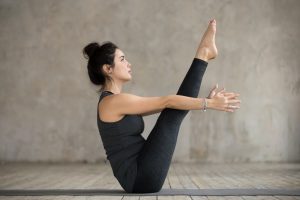The core is responsible for the majority of physical activity we do. This is why the benefits of building a strong core are not only helpful in the gym, but also in broader life. In this post, we discuss why you should be training your core. After this, we look at great core exercises to work into your routine.
Why Is a Strong Core Important?
The core is also known as “The Power House” and is where the body’s centre of gravity is found. In fact, the core is responsible for initiating all movements, it is key to stability and balance. Alongside this, the core ensures co-ordination in movement (Handzel, 2003).
Having a weak core can lead to increases in fatigue levels. This is because the other muscles have to kick in and compensate for the weak ones. As well as this, an untrained core leads to an increased risk of injuries, due to other smaller having to do more work than they’re designed to.

The Benefits of Building a Strong Core
Not only do toned abs look good but they also have amazing health benefits. From the above, some of the benefits of building a strong core are already clear. As well as avoiding overworking weaker muscles, you’ll have better balance and coordination. Alongside this, you’ll lower your risk of injury. A strong core can improve your posture and may help ward off aches and injuries (Hibbs, 2008). As well as protecting your organs, improved coordination and balance mean one of the benefits of building a strong core is a better technique in the gym.
Many popular fitness programmes are all based around strengthing the core. For example, Pilates is an exercise programme with a core stability approach. It ties in the neuromuscular system, which controls and protect the core and spine. This method coordinates core stabilizing exercise with breath control (Phrompaet, 2011).
How to Build a Strong Core
It’s important to understand that training your core doesn’t just mean focusing on abs. To get the benefits of building a strong core, you need to look at the bigger picture. As well as the abs, the back, pelvis, and hip muscles are part of the core. To train these effectively, we need to learn how to activate our deep core muscles. These include the multifidus, pelvic floor and transverse abdominus (McGill, 2010).

Engage Your Entire Core
My three most important tips for engaging all of your core muscles include:
- Firstly, slow down. Making your exercises faster will encourage poor technique with inadequate control. Slowing your movement down allows your muscles to control it and helps improve your overall technique.
- Also important is to learn a neutral spine. This is important for your posture. Doing this ensures that you’re not getting too much rounding or dipping in your back. This can be hard for people that may have got into bad postural habits. This being said, with persistence, you can correct this.
- In addition, focus on your breathing. Ensure that you breathe throughout your exercises. Not breathing will cause your whole body to tense up. Not only can this be uncomfortable, but it can also cause you to recruit the wrong muscle groups.
How a Strong Core Benefits The Rest of the Body
Back pain is a common feature of a weak core. If your core is unable to support your body, your back muscles compensate. This leads to them growing too strong and results in imbalances. In turn, this can lead to lower back pain. In my experience, clients who suffer from back pain often have a weak core. Core instability can result in many different pain symptoms such as difficulty standing after bending forwards and impaired single leg balance. Alongside this, you might feel sudden jolts of back pain for no reason (Stewart, n.d.) One of the benefits of building a strong core is alleviating back pain symptoms.

If your core isn’t strong, then your lower and upper limbs won’t work as effectively. There is a strong correlation between trunk movement and upper limb function (Wilson et al., 2005). Stroke victims have rehabilitation focusing on core stability to improve the quality of arm function (RCP, 2016). From this, it’s clear that the benefits of building a strong core extend even to limb function, which can help coordination.
How To Train Your Core
Many people get stuck as to what to do when working the core. To reap the benefits of building a strong core, it’s key to know how to train effectively.
Circuits are a great way to incorporate core training. Keep these simple but effective. Don’t do too many exercises, as the core can fatigue quickly. Alongside this, make sure you perform each movement for a realistic time. Most core exercises can be done in a gym or home environment. The circuit below can be completed in both:
Core Circuit
- V-Sits. If you’re only just beginning core training, start by doing them with tucked legs.
- Plank hold. Hold a plank for approx. 1 minute
- Mountain climbers. Use a controlled range of movement when bringing the knees up to your chest.
- Dish hold. Arms and ankles off the floor not too high.
- Dead bug. Hold this position for around 1 minute.
- Crunches. If you find these difficult, use support to help hold your legs in position.
Repeat the circuit three times with a two-minute rest in between each circuit. When doing this, think of keeping your core (not just my abs) engaged, so that you work the total core area.

The Benefits of Building a Strong Core: Summary
The benefits of building a strong core are not just for the gym. A strong core is beneficial for all physical activity, as well as balance, coordination, and posture. Alongside this, training your core can help fix imbalances, and improve your exercise technique.
So, make sure to incorporate core work into your next training plan! Before you do so, check out how to choose the best workout plan here. A strong core is also a focus of gymnastics training. Find out about the other key elements of a gymnast’s daily workout here.
